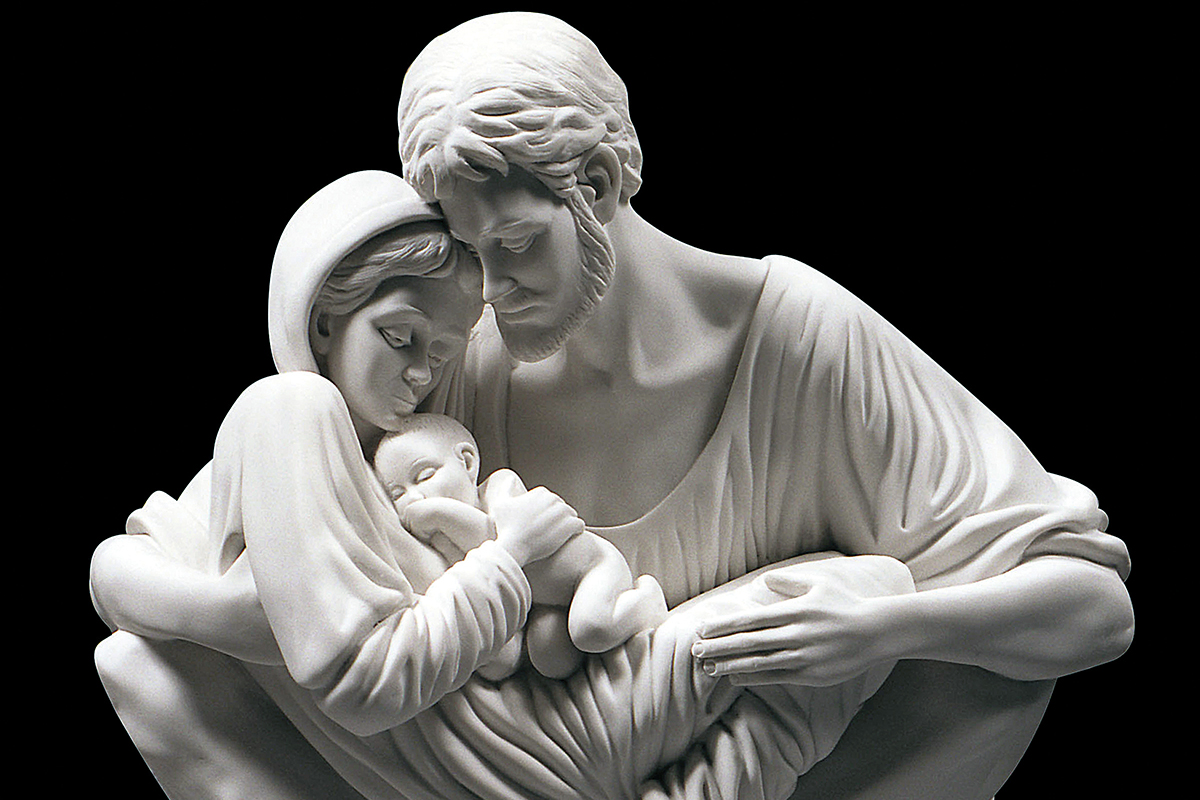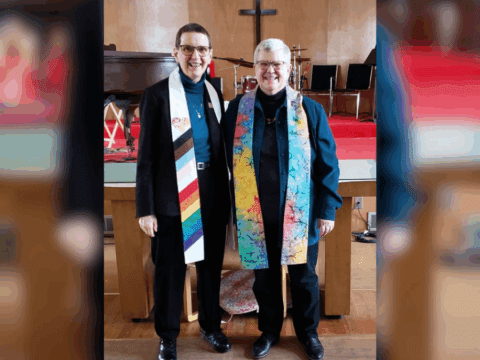On the surface, artistic portrayals of Jesus’ birth are predictable. There’s the usual cast of characters: either Mary and Jesus alone or the whole scene — the holy family, shepherds, angels, wise men and a brood of animals. These visions have so saturated the Christian imagination that at first glance, we chalk them all up to a genre of art we’ve seen a thousand times before. But dig more deeply into the variations on the theme and what appears on the surface to be a singular idea morphs into a dazzling array of messages.
Since the first representation of Jesus’ birth in the fourth century, Christian artists have conveyed the meaning of the divine incarnation not by changing the cast but by casting the scene differently. In this roundup of renditions of the birth of Christ, contemporary Canadian artists put their mark on the holy configuration: William Kurelek imagines Jesus’ birth in a variety of Canadian contexts as if to say that at any moment, Christ could be born among us. Timothy Schmalz pushes the viewer to see past stereotypes to imagine the divine born in our image, regardless of our racial identity.
Animals have played a key supportive role in traditional Nativity art despite the fact that none of the Gospels hint they were there. We’ve come a long way from the original ox and ass duo, representing Israel and the Gentiles. Yukon artist Nathalie Parenteau and Indigenous artist Jackson Beardy imagine all manner of animals at the scene. No matter which furry friends sidle up to Jesus, their presence suggests that on that night, all of creation took note. Beardy goes further, explaining in a written statement that the creatures have “come to see the messenger. He is born to explain their existence, to restore harmony between humanity and the elements, physically, mentally, and spiritually.”
It’s hard to contemplate the Nativity without animals. Or a stable for that matter. The Gospel of Luke mentions that Jesus was laid in a manger but the idea that the manger was located in a barn of some kind is intuited. Christian artists in the fourth and fifth centuries were fond of painting stables but by the sixth century, artists in Byzantine Syria took Jesus out of a barn and placed him in a dark mountain cave, suggesting that he is a beacon in a cold and hard world. This is the period from which Canadian iconographer Marianna Savaryn takes her lead.
Jesus’ birth has long captured the artistic imagination. Canadian artists have expressed their vision on stamps and cards, in books and in galleries. Look closely and you’ll find that the images don’t just convey the old, old story. Each visual take on the familiar scene invites us to a spiritual birth of our own.

Virgin Mary with Christ Child and Saint John the Baptist
Norval Morrisseau
Until the 1960s, Indigenous art was shown in anthropology museums or treated as gift-shop merchandise rather than exhibited in mainstream galleries. Anishinaabe artist Norval Morrisseau’s groundbreaking 1962 exhibition at the Pollock Gallery in Toronto made him the first Indigenous artist to break into the Canadian professional art scene. Born in 1932, Morrisseau was raised by his shaman grandfather and Catholic grandmother, and educated in a Catholic residential school. His art reflects his checkered spiritual roots and explores the tensions between Indigenous and European traditions. Painted in 1973, Virgin Mary with Christ Child and Saint John the Baptist’s bold colour, heavy lines and mystical essence typifies Morrisseau’s work. “My paintings . . . are images which help focus on spiritual powers, generated by traditional belief and wisdom,” Morrisseau is quoted as saying in The Art of Norval Morrisseau by Lister Sinclair and Jack Pollock. “I also regard myself as a kind of spiritual psychologist. I bring together and promote the ultimate harmony of the physical and the spiritual world.” Morrisseau died in 2007.

Nativity
Marianna Savaryn
Painting as a child and growing up with the rich icons of the Ukrainian Catholic Church, iconography was a natural fit for Hamilton artist Marianna Savaryn, whose work graces cathedrals and homes across Canada and abroad. Tradition is part of the appeal. “Iconography is dedicated to continuing what started between 400-1400 C.E., initially to teach people who were illiterate. As an iconographer, I work from a prototype. But like a musician who plays Beethoven, each artist is going to render it a bit differently,” she explains. Nativity falls into the category of festal icons, depicting a major event in Jesus’ life. The symbols in Savaryn’s work are a language of their own, immediately recognizable to those who know iconography. “For instance, the mountainous range in iconography is symbolic of our prayers going to heaven. Christ is swaddled in a cloth that symbolically represents his birth and his death. . . . The concept of iconography in one sentence is to bring light into the world. It’s acting as a window into the heavenly sphere,” she says. “The icon is not complete until the person comes before it.”

Arctic Holy Night
Nathalie Parenteau
A muskox and a white wolf aren’t traditionally part of the Nativity flock. But for Whitehorse biology graduate turned artist Nathalie Parenteau, they are a perfect fit. “I wanted to give a sense of warmth and protection. I’ve studied a lot about animals and love every single being. I want to bring into peoples’ lives the feeling that all around us there are beings that accompany us on our journey in life,” she explains. “In certain cultures, animals are seen as guides. I think that on that night, everyone got along.” In addition to her other art, Parenteau produces a Christmas card image each year, and Arctic Holy Night was 2010’s design. While she doesn’t identify as Christian, Parenteau began painting the Nativity because she needed a break from creating Santa cards. “I wanted something more introspective, not geared toward gifts and lights but the more spiritual part. I was raised with a Quebec Catholic background so the story is very present. I have been living in the north for a long time and so I mixed these two things,” she says. Parenteau’s work is currently sold in over 40 galleries across Canada and Alaska.

A Northern Nativity: Christmas Dreams of a Prairie Boy
(Tundra Books, 1976)
William Kurelek
The broad strokes of artist William Kurelek’s life are disturbing: Born to Ukrainian parents in Alberta in 1927, Kurelek frequented psychiatric hospitals, attempted suicide and endured electroconvulsive therapy. The suffering that saturates so much of his work shaped his genius. In 1976, Kurelek wrote and illustrated A Northern Nativity in which he renders the Nativity in offbeat settings, the figures lonely yet peaceful in each. The Niagara Falls Art Gallery houses about 200 pieces of Kurelek’s work. “His whole life was tormented. There are periods where his faith, his Catholicism, sort of takes over. But he is still tormented. It comes out in all of his paintings,” says Executive Director Debra Attenborough, adding that Kurelek is noteworthy for his nostalgic work, his exploration of immigrants and his social commentary, particularly on nuclear war. Kurelek died of cancer in 1977 as a result of painting with toxic chemicals in the bomb shelter studio he constructed beneath his house, fearing a nuclear Armageddon. A year before his death, he was made a member of the Order of Canada.

Nativity
Jackson Beardy
In 1975, the Canadian Conference of Catholic Bishops commissioned 20 artists to create pieces on Christian themes. Manitoba-born Cree artist Jackson Beardy, who attended a residential school and later studied then taught art at the University of Manitoba, painted the Nativity. Its flat colour, heavy outlines and x-ray quality typifies Beardy’s style. “We see the virgin mother-to-be holding on to an embryo connected to the sun symbol (the Great Spirit) who has deemed it necessary to send his messenger to his people. The mother is also connected to Mother Earth who is nursing her,” explains Beardy in a statement now posted on the CCCB website. “On the other side of the sun symbol we see an elder in prayer, ritually offering a bowl filled with sacred things. You can see the sun symbol is resting on his hunched frame . . . bearing him down with doubts, fear, depression, and all the ills of his time.” Beardy was well acquainted with illness. Substance abuse caused him ulcers that plagued him long after he had given up alcohol. Beardy died in 1984 at age 40. A memorial service was held in the Manitoba legislative building in his honour.

Canada Post: 2009 Madonna and Child Stamp
Joseph Gault, designer, and Antonio Caruso, artist
Canada Post began featuring Nativity art on stamps in 1965. Toronto graphic designer Joseph Gault won the contract to design the Nativity stamps for 2008 through 2010. Finding the right artist’s work to feature on the stamp wasn’t easy. “The problem with designing something an inch in height is that it can get very busy at a very small size very quickly. The other thing is that it has to be able to communicate very fast,” explains Gault, who scoured thousands of nativities before settling on lime wood pieces sculpted by renowned Italian-Canadian artist Antonio Caruso. “The detail is phenomenal. They are only about two to five inches in height but you can see the ridges on the fingernails.” Gault contracted a photographer to photograph Caruso’s sculptures against a backdrop, which he then digitally altered to look like sand, adding sunrays to give the pieces an ethereal quality. The design process took over a year to complete. (Caruso could not be reached for comment.)

The Huron Carol
(Lester & Orpen Dennys, 1990)
Frances Tyrrell
Burlington, Ont., artist Frances Tyrrell was shocked when she got a call from Lester & Orpen Dennys, a now-defunct publishing house, to illustrate The Huron Carol, a 1990 picture book illustrating Jesuit missionary Jean de Brébeuf’s 17th-century lyrics. From her home office, Tyrrell marvels at the surprising chain of events when a Nativity drawing she did for her father’s business Christmas cards was discovered by Carleton Cards, which in turn piqued the interest of a publisher. “It never happens that a publisher asks someone who has never done a book before, ‘Would you like to do the book?’ I felt that I was touched by grace,” she says. Conducting her research before the advent of the Internet, Tyrrell relied on libraries and a friend who worked for the Ontario First Nations to get the details right in The Huron Carol, including the feathers, stitching, buckskin, fur and faces, and not “imposing a European stereotype of First Nations on it.” Since then, Tyrrell’s watercolours have graced several books, her style light, detailed and luminous. Tyrrell describes her work as heartfelt. “The Huron Carol meant a lot to me. I was reaching for a universal humanity, dignity. . . . I feel like a humble, but I hope worthy, part of history,” she says.

African American Madonna and Child
Timothy Schmalz
A recording of the King James Bible narrated by a fellow with a British accent has animated Timothy Schmalz’s studio in St. Jacobs, Ont., for the last two years. The readings allow Schmalz to attain the contemplative state of mind needed for him to sculpt. Best known for his Homeless Jesus sculpture displayed in the Vatican, Schmalz’s work pushes the boundaries. His portrayals of Jesus’ infancy lifts up the under-represented: Mary is portrayed as African American, Joseph’s role as Jesus’ human father is celebrated. “One of the most challenging things in our world is the message of Christianity. One would not know that by looking at the pretty artwork that has come out of the last hundred years,” explains Schmalz. “Christianity is often misrepresented by the beautiful. Christianity is not just comfort food — although it’s comforting, but it’s also a challenge. It asks us to be more, to tolerate more.” Schmalz is once again poised to push the boundaries as he unveils his latest sculpture: a rendition of Jesus embracing a terrorist. “Part of me is revolted by it,” he admits. “To love one’s enemies is unsettling and difficult work to do.”
This story first appeared in The United Church Observer’s December 2016 issue with the title “The Nativity re-imagined.”















